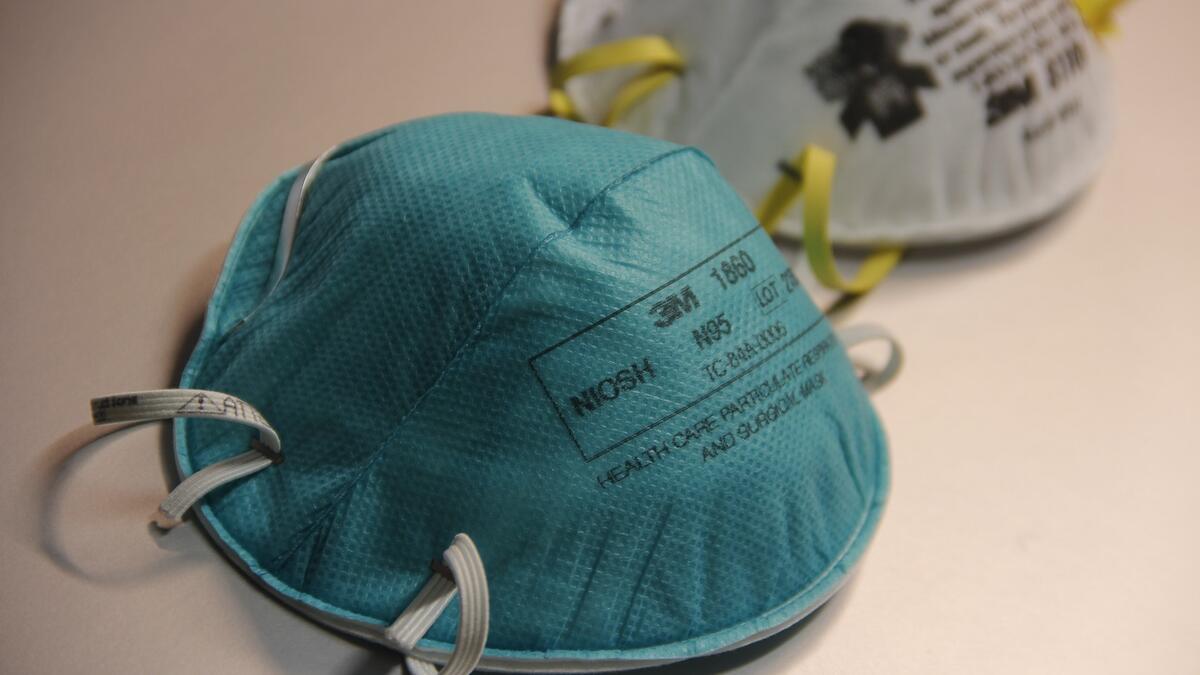ASU-led study finds use of respirator masks could have prevented spread of COVID-19

Photo by CDC from Pexels
The Centers for Disease Control and Prevention and other public health agencies recommend wearing masks to prevent the transmission of COVID-19, but does the kind of mask — cloth, surgical or respirator — make a difference?
According to a new study published Sept. 8 in Royal Society Open Science, if only around half of the population opted to wear respirator-type masks from the beginning of the pandemic, COVID-19 would have failed to establish in the United States.
Abba Gumel, a Foundation Professor in the School of Mathematical and Statistical Sciences at Arizona State University, led the research team.
“We were interested in determining effective ways to combat or mitigate the burden of a respiratory disease with pandemic potential during the very early stages, before pharmaceutical interventions, such as vaccines and antivirals become available,” Gumel said. “The standard methods are typically based on quarantine of people suspected of being exposed to the disease and the isolation of those with symptoms. These measures have been shown to be largely ineffective when dealing with highly contagious diseases, such as COVID-19.”
With COVID-19 rampaging the world, the researchers thought of exploring the potential impact of a widespread deployment of high-quality masks during the very early stages of the pandemic on the burden and trajectory of the pandemic.
Mixed messages have led to confusion and misunderstanding in the general public about masks and their effectiveness.
“Public health messaging around masking was initially unclear, and the politicization of masking, of course, didn't help matters either,” Gumel said. “Since the beginning of the year, the messaging around masking has greatly improved, the only main problem being mask fatigue and the politicization effect which, sadly, still lingers in the minds of a sizable proportion of the populace.”
In the study, different types of masks are defined along with their purpose and efficacy. Cloth masks and surgical or procedure masks are considered to be loose fitting face coverings and are designed to prevent the spread of disease from infected wearers to those around them, but not to protect the wearer from others. Efficacy of cloth masks is difficult to determine due to their unregulated nature and variation in design and construction. Surgical masks are also designed to be loose fitting but are made from materials that have a theoretical filtration efficiency of up to 85%. Due to their lack of a tight seal, the real-world filtration efficiency is likely much lower.
ASU Foundation Professor Abba Gumel
In contrast to cloth and surgical masks, most respirators are designed to fit tightly to the face and represent true respiratory protection, protecting the wearer from respiratory hazards around them. Respirators are defined as tight-fitting respiratory protective devices that meet or exceed the National Institute for Occupational Safety and Health (NIOSH) standard, and include N95, N99, N100, R95, P95, P99 and P100. Estimates for the efficiency of these filtering face-piece respirators are nearly 100% for charged biological particles such as respiratory aerosols.
Due to the highly protective nature of properly fitting respirators, health care workers have worn these devices for protection from COVID-19 throughout the pandemic.
Previous mathematical modeling studies have focused on the role of cloth and surgical masks when adopted by a large majority of the population. What has not been clear is the potential role that respirator-type masks could serve outside of health care and what level of use in the population would be necessary to have a significant impact.
The researchers formulated a basic mathematical model for the transmission dynamics of COVID-19 in a population where a certain proportion habitually wear face masks. They considered four categories of face masks: cloth masks (with estimated efficacy of 30%), improved cloth masks or poorly fitted surgical masks (with estimated efficacy of 50%), properly fitted surgical masks (with estimated efficacy of 70%) and properly fitted respirators (with estimated efficacy of 95%).
The first set of simulations assessed the impact of early implementation of mask use strategy in the United States. They simulated the scenario where only one of the four mask categories is adopted in the community, and they used the baseline values and parameters corresponding to the first wave of the pandemic. The results showed that the early implementation of universal face mask use strategy, with compliance of 80%, resulted in a dramatic reduction in the burden of the pandemic. If 80% of Americans were wearing respirators starting from March 15, 2020 (which was four days after the World Health Organization declared COVID-19 to be a global pandemic), up to 84% of the nearly 128,000 deaths recorded by June 30 would have been prevented.
The team ran additional simulations of the basic model combining the impact of mask usage with other non-pharmaceutical interventions (NPIs), such as social distancing, avoiding large gatherings, avoiding indoor dining in restaurants, etc. Since the model used COVID-19 data from the onset of the outbreak in the U.S. (from January 20, 2020 to mid-March 2021), the combined effects of other NPIs were already embedded in the results. This means the model calibration includes some baseline level of the other NPIs implemented in the community. The simulations showed that if individuals in the community choose to use cloth masks only, with an estimated efficacy of 30%, COVID-19 would continue to spread.
In contrast, better quality masks required less people wearing them in order to effectively control spread of the disease. If only 40% of Americans had been wearing the highly effective respirator masks right from the beginning of the outbreak, the pandemic could have been eliminated.
Additional simulations were conducted to assess the combined impact of using different kinds of face masks and other NPIs, using April 30, 2021, as the reference time for comparison purposes. The results again showed that respirators are far more effective in curtailing COVID-19 mortality than any other mask type. The simulations also showed that the effectiveness of each mask type improved when combined with an increase in the baseline levels of other NPIs.
The study provided a range of plausible NPI-based scenarios for effectively controlling the spread of COVID-19 in the U.S. that would not necessarily require major economic disruptions, such as imposing community lockdowns or wide-scale business and school closures. Just as in the prior two deadly global outbreaks of SARS and MERS, the study suggests that COVID-19 is controllable using basic public health interventions, using a strategy that prioritizes high-quality masks.
“The ‘hit hard, hit early’ mantra, using high quality masks with high compliance, is the best way to suppress deadly pandemics — before vaccines and antivirals become available,” said Gumel. “Our study shows that if we universally had started masking up early, and using high quality masks, COVID-19 would not have taken up in the U.S. — and the nearly 670,000 lives we lost didn't have to die. It is in our collective best interest to stockpile high quality masks, particularly respirators, and massively deploy them in times of new contagious and deadly respiratory pandemics.”
Authors of the study include: Calistus N. Ngonghala, University of Florida; James R. Knitter, University of Arizona; Lucas Marinacci, Beth Israel Deaconess Medical Center and Harvard Medical School; Matthew H. Bonds, Harvard Medical School; Abba B. Gumel, Arizona State University and University of Pretoria, South Africa.
Abba Gumel acknowledges the support, in part, of the Simons Foundation under award 585022 and the National Science Foundation under grant DMS-2052363. Calistus N. Ngonghala acknowledges the support of the Simons Foundation under award 627346.
More Science and technology

Indigenous geneticists build unprecedented research community at ASU
When Krystal Tsosie (Diné) was an undergraduate at Arizona State University, there were no Indigenous faculty she could look to…

Pioneering professor of cultural evolution pens essays for leading academic journals
When Robert Boyd wrote his 1985 book “Culture and the Evolutionary Process,” cultural evolution was not considered a true…

Lucy's lasting legacy: Donald Johanson reflects on the discovery of a lifetime
Fifty years ago, in the dusty hills of Hadar, Ethiopia, a young paleoanthropologist, Donald Johanson, discovered what would…
